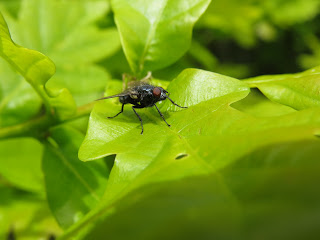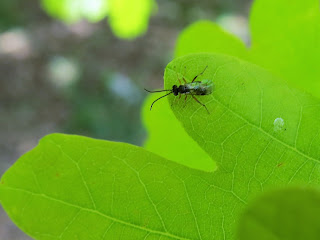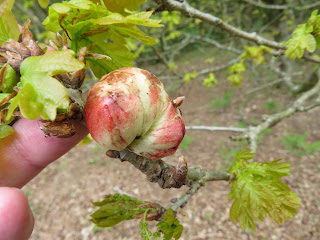 |
| Oak Tree in flower |
Trees are on my mind today. After saying goodbye to my favourite beech tree as chainsaws got to work on it, I went to Mousehold to look for acorn weevils. These tiny beetles live up amongst oak tree leaves. With so many leaves to check, how was I meant to find one? Well, there is one easy method that apparently works and I wanted to try it out. All you need is a white sheet (or pillowcase in my case) and some muscles as you shake a branch and watch the contents tumble down to the sheet. Annoyingly for me, it didn't really work. All I managed to catch were bits of oak tree. Perhaps I need a bigger sheet? Or maybe some workout with those muscles of mine?
 |
| Gall Wasp /Sawfly? |
I may not have found any weevils, but there were many other things that I did manage to see (though most of them can fly and avoid a tumble!). Swarming over the leaves were many tiny wasp or sawfly-like things. I'm not completely sure of what exactly they were, but they seem to be interested in the leaves. I think they were laying their eggs within the leaf's structure, stabbing their ovipositor into the leaf. If this is the case, these could be one of the many species of wasp or sawfly that can create galls.
 |
| Oak Apple galls |
A gall is a strange growth that grows on a plant that is manipulated by certain species of insect or mite or even other things such as fungi. They come in all manner of shapes, sizes and colours. A single oak tree can be infested in many different species of gall. Most of them are more visible later in the year, but the most common that you will find right now are oak apples. These galls look a bit like small apples with some growing up to 45mm across and are reasonably soft inside. Within the centre of these apples are numerous developing wasp larvae, which don't emerge until June-July.
 |
| Some kind of inchworm caterpillar |
If you look carefully enough, you can end up discovering so many tiny creatures. Take this tiny caterpillar, which I found crawling along some bare ground. One day it will develop into a moth, though I am not sure which species it will become. If this tiny guy was on a leaf, it would be extremely difficult to spot as it will hug the edge of the leaf it's eating whenever a predator is nearby and it will stay as still as it can, almost becoming part of the leaf. This type of caterpillar is known as a looper or inchworm as it moves by arching it's body along.

 |
| Female Orange-tip |
 |
| St Mark's Fly |
 |
| Crane-fly |
 |
| A Fly of some kind |
 |
| Dock Bug |
 |
| A Fly of some kind |
 |
| Green Longhorn Moth |
 |
| Some kind of bee |
 |
| Harlequin Ladybird |
 |
| Green Hairstreak |
If there was a good replacement for my main target (the acorn weevil) today, then it has to be the green hairstreak. This tiny green butterfly is one of my favourites and can be hard to spot. They are a bit of a specialty at Mousehold and during May, Will and I have to be more observant when tallying them up whilst on butterfly surveys. Speaking of which, I bumped into Will and joined him for a short while as he continued with today's survey. Thanks to him, we watched a pair of green hairstreaks defending a patch of gorse bushes. I left Will to his survey so that I could get some photos of this individual sunning itself. Unlike most butterflies, hairstreaks prefer to sun themselves with their wings closed and tilting to one side.
 |
| Peacock |
 |
| Jay |
 |
| Common Frog |






























I went on a workshop looking at how to find and identify bugs and beetles a couple of years ago, and one of the tips they gave was to hit a tree branch with a stick to get the insects to fall onto the sheet/pillowcase rather than shaking the branch. The logic is that insects are used to the wind, so they hang on tight in the face of a shaking motion, but a quick sudden whack surprises them and they release their grip!
ReplyDeleteThanks for the tip. I will try this next time. Any idea what the wasps are?
ReplyDeleteNo problem, and good luck! No is the short answer! I think you are right that they are Sawflies or gall wasps, but shape wise there is a lot of overlap, and there are no good books that I'm aware of that show the whole range of species unfortunately, making a firm ID tricky for many of them.
ReplyDelete